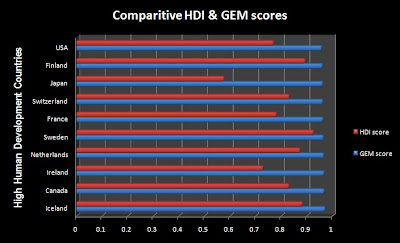 The Human Poverty Index (HPI) is an indication of the standard of living in a country, developed by the United Nations (UN). For highly developed countries, the UN considers that it can better reflect the extent of deprivation compared to the Human Development Index (HDI).
The Human Poverty Index (HPI) is an indication of the standard of living in a country, developed by the United Nations (UN). For highly developed countries, the UN considers that it can better reflect the extent of deprivation compared to the Human Development Index (HDI).
There are two separate formulas for calculating the HPI. One formula measures the poverty index in developing countries. The Human Development Reports (HDR) website summarizes the first formula as a composite index measuring deprivations in the three basic dimensions captured in the HDI — a long and healthy life, knowledge and a decent standard of living (HDR 2009). This first formula, called HPI-1, is calculated using three factors:
- Probability at birth of not surviving to age 40.
- Adult literacy rate.
- Unweighted average of population without sustainable access to an improved water source and children underweight for age.
 ration and Development (OECD). OECD members are high-income economies with a high HDI and are regarded as developed countries. A list of these countries can be found here. The (HDR) website summarizes this second formula as a composite index measuring deprivations in the three basic dimensions captured in the HDI — a long and healthy life, knowledge and a decent standard of living - and also capturing social exclusion (HDR 2009). This second formula, called HPI-2, is calculated using four factors:
ration and Development (OECD). OECD members are high-income economies with a high HDI and are regarded as developed countries. A list of these countries can be found here. The (HDR) website summarizes this second formula as a composite index measuring deprivations in the three basic dimensions captured in the HDI — a long and healthy life, knowledge and a decent standard of living - and also capturing social exclusion (HDR 2009). This second formula, called HPI-2, is calculated using four factors:- Probability at birth of not surviving to age 60.
- Adults lacking functional literacy skills.
- Population below income poverty line (50% of median adjusted household disposable income).
- Rate of long-term unemployment (lasting 12 months or more).
 As already discussed, one of the factors that measures a country's HPI is the probability of the population not reaching a certain age. The graph below illustrates the formula, HPI-2, examining selected OECDs and their corresponding death mortality for people reaching the age of 60.
As already discussed, one of the factors that measures a country's HPI is the probability of the population not reaching a certain age. The graph below illustrates the formula, HPI-2, examining selected OECDs and their corresponding death mortality for people reaching the age of 60. Another factor looking at the HPI of the OECDs is long-term unemployment. This demographic contains far greater discrepancies, with some countries (including the USA having the world's lowest at 0.4%) while other countries like Germany and Belgium having far greater unemployment figures. The graph below lists the same 20 OECD countries as the one above.
Another factor looking at the HPI of the OECDs is long-term unemployment. This demographic contains far greater discrepancies, with some countries (including the USA having the world's lowest at 0.4%) while other countries like Germany and Belgium having far greater unemployment figures. The graph below lists the same 20 OECD countries as the one above.  Yet another factor calculated into a country's HPI is the percentage of the population below 50% of the median GDP per capita income. This is also a measure of economic inequality within a country. As shown on the graph below, the USA has the highest percentage of people living in poverty (as characterized by making less than 50% of median income). This poverty measurement is not a universal formula, however. The US defines the poverty threshold at a household's monthly food expenditures times three. Using this formula, the poverty level in this country is less than the 17% figure listed below; current estimates have the poverty rate at 13.2% - though this 11-year high is attributed mainly to the recession. (Homan & Dorning, 2009).
Yet another factor calculated into a country's HPI is the percentage of the population below 50% of the median GDP per capita income. This is also a measure of economic inequality within a country. As shown on the graph below, the USA has the highest percentage of people living in poverty (as characterized by making less than 50% of median income). This poverty measurement is not a universal formula, however. The US defines the poverty threshold at a household's monthly food expenditures times three. Using this formula, the poverty level in this country is less than the 17% figure listed below; current estimates have the poverty rate at 13.2% - though this 11-year high is attributed mainly to the recession. (Homan & Dorning, 2009). The graph listed below combines the four factors that are in the HPI-2 formula for selected OECD countries. Click to enlarge
The graph listed below combines the four factors that are in the HPI-2 formula for selected OECD countries. Click to enlarge

Homan, T.R., & Dorning M. (2009, September 10). U.S. Poverty Rate Rises to 11-Year High as Recession Takes Toll. Bloomberg News. Retrieved December 13, 2009, from http://www.bloomberg.com/apps/news?pid=20601087&sid=aDIvtqxX.pxY
“Human Poverty Index”. (2009, December 8). Wikipedia. Retrieved December 13, 2009, from http://en.wikipedia.org/wiki/Human_Poverty_Index
Human Development Report 2009. United Nations Development Programme. 2009. Retrieved from http://hdr.undp.org/en/media/HDR_2009_EN_Complete.pdf









